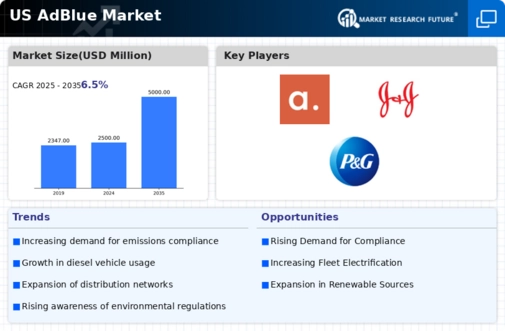The ad blue market is currently characterized by a competitive landscape that is both dynamic and multifaceted. Key growth drivers include stringent environmental regulations, the increasing adoption of diesel vehicles, and a heightened focus on reducing nitrogen oxide emissions. Major players such as Yara International (NO), CF Industries (US), and Koch Industries (US) are strategically positioned to leverage these trends. Yara International (NO) emphasizes innovation in production processes, aiming to enhance efficiency and sustainability. CF Industries (US) focuses on expanding its production capacity to meet rising demand, while Koch Industries (US) is investing in digital transformation initiatives to optimize its supply chain and improve customer engagement. Collectively, these strategies contribute to a competitive environment that is increasingly shaped by technological advancements and regulatory compliance.
In terms of business tactics, companies are localizing manufacturing to reduce transportation costs and enhance supply chain resilience. The market structure appears moderately fragmented, with several key players holding significant market shares. This fragmentation allows for competitive pricing strategies, yet the influence of major companies is substantial, as they set industry standards and drive innovation.
In November 2025, Yara International (NO) announced a partnership with a leading technology firm to develop a new digital platform aimed at optimizing the distribution of ad blue. This strategic move is likely to enhance operational efficiency and improve customer service, positioning Yara as a frontrunner in the digital transformation of the market. The integration of advanced analytics into their supply chain could potentially streamline operations and reduce costs.
In October 2025, CF Industries (US) unveiled plans to expand its production facility in Louisiana, which is expected to increase its output capacity by 30%. This expansion is strategically significant as it aligns with the growing demand for ad blue in the North American market, allowing CF Industries to solidify its market position and respond effectively to customer needs. The investment reflects a commitment to meeting regulatory requirements and supporting the transition to cleaner fuels.
In September 2025, Koch Industries (US) launched a new initiative focused on sustainability, aiming to reduce the carbon footprint of its ad blue production by 25% over the next five years. This initiative underscores the company's commitment to environmental stewardship and positions it favorably among environmentally conscious consumers and regulatory bodies. The emphasis on sustainability is likely to resonate well in a market increasingly driven by eco-friendly practices.
As of December 2025, current competitive trends indicate a strong shift towards digitalization, sustainability, and the integration of artificial intelligence in production processes. Strategic alliances are becoming increasingly important, as companies seek to enhance their technological capabilities and market reach. The competitive differentiation is expected to evolve from traditional price-based competition to a focus on innovation, technology, and supply chain reliability. This shift suggests that companies that prioritize these aspects will likely gain a competitive edge in the evolving landscape of the ad blue market.














Leave a Comment